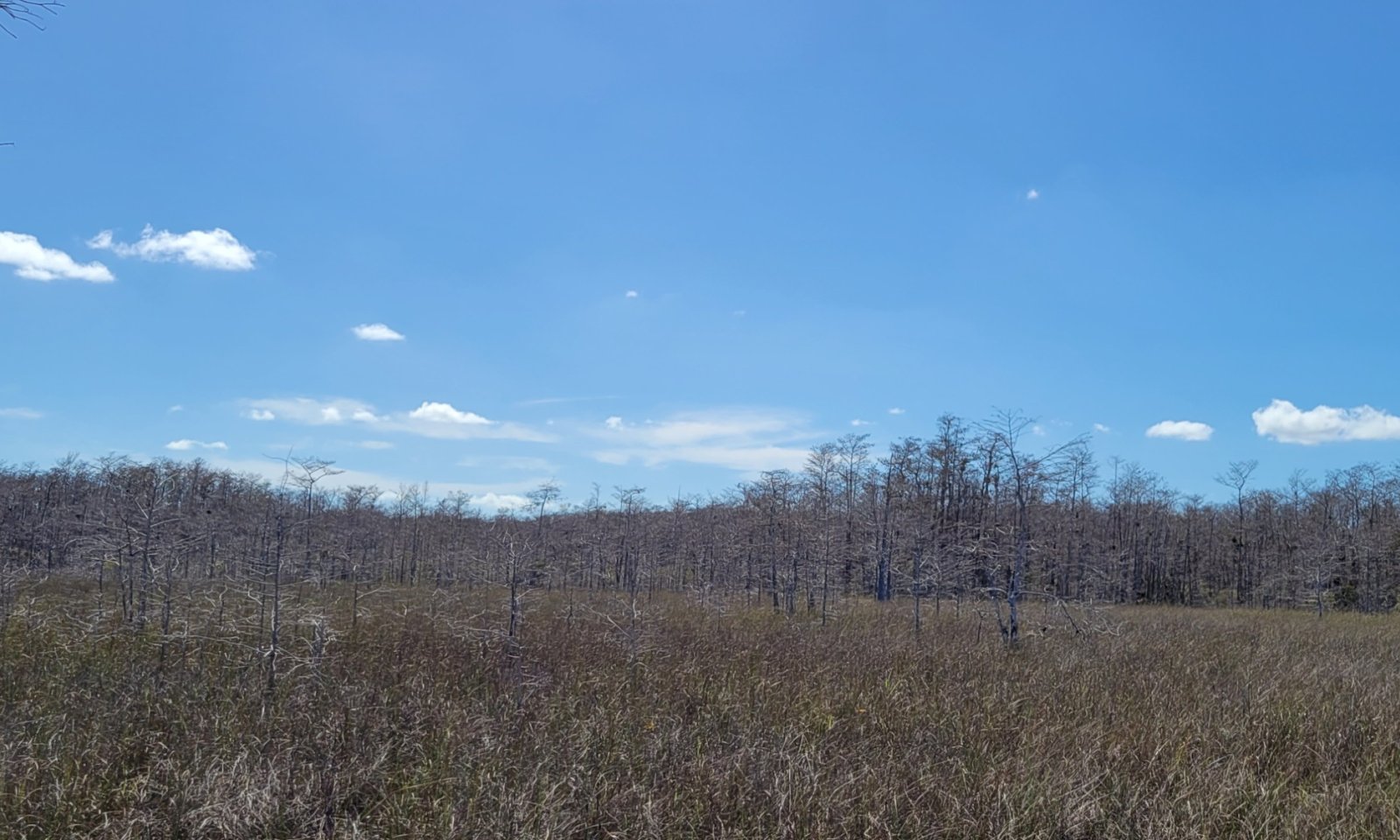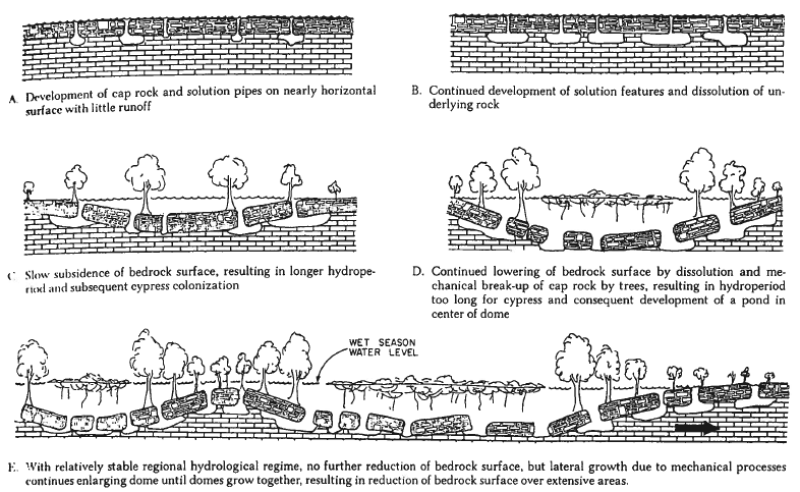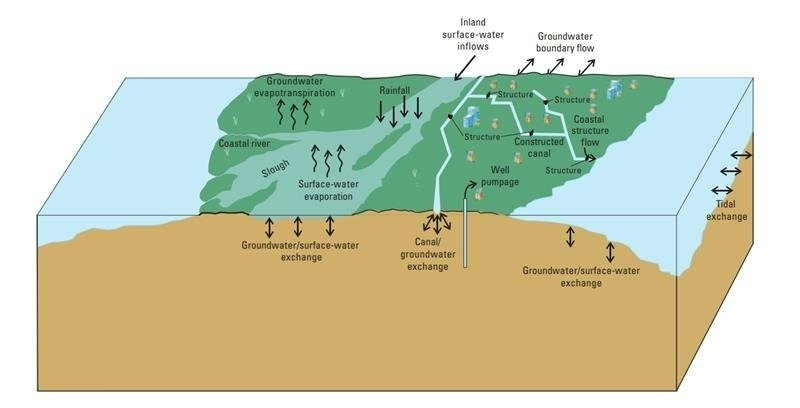Ecological dynamics
The information presented in this ecological site description (ESD) and state-and-transition model (STM) were developed using archaeological and historical information, published and unpublished scientific reports, professional experience, consultation with technical experts, and NRCS inventories and studies. The information presented represents a complex set of plant community dynamic and environmental variables. Not all scenarios or plants are represented and included. Key indicator plants, animals, and ecological processes are described to help guide land management decisions and actions.
This site is found in depressions dominated by hydrophytic trees within the Big Cypress ecoregion. These are wet sites with long hydroperiods and rare fires that produce sparse understory vegetation and allow both deciduous and coniferous tree species. Cypress species are tolerant of long hydroperiods but do not grow when inundated, slowing cypress growth to only a few months during the dry season. During the dry season herbaceous species may be present on the surface when water is drained from the system. Extended hydroperiods may prevent reproduction by inhibiting seed germination or drowning seedlings. For new cypress trees to survive they must grow enough to survive inundation of the next wet season. Slow moving water from the northeast (Lake Okeechobee / Okalaocoochee Slough) to the southwest (gulf) allows cypress to grow much better than in standing water due to increased aeration and nutrient availability. During periods of extended drought, invasion of long hydroperiod intolerant hardwood species might occur, assisting transition to an altered ecological state in the absence of fire as well.
Infrequent to occasional fires are common in these communities, preventing hardwood invasion and peat accumulation that would convert the cypress swamp to a bayhead. Cypress swamps dominated by bays are close to this transition. Fire frequency is greatest at the periphery of the dome and least in the interior, where long hydroperiods and deep peat maintain high moisture levels for most of the year. The normal fire cycle might be as short as 3 to 5 years along the outer edge and as long as 100 to 150 years towards the center. The profile of a cypress swamp (i.e., smaller trees at the periphery and largest trees near the center) is attributable to this fire regime. The shorter hydroperiods along the periphery permit fires to burn into the edge more often, occasionally killing the outer trees and burning surficial organic matter, preventing accumulation. Cypress is very tolerant of light surface fires, but muck fires burning into the peat can kill them, lowering the ground surface, and transform a swamp into a shrub dominated wetland. Where severe fires have killed cypress, coastalplain willow and bay species commonly establishes as a thicket.
Within cypress swamps, topographic microsites can be found building on cypress knees and buttressed trunks, providing important habitat for trees, shrubs, and other herbaceous seedlings. Raised mats of root fibers and peat form hummocks at the bases of trees and shrubs or on old tree stumps, allowing a more diverse and mesic microsite to establish above the seasonally high-water levels. Buttresses of the cypress trunks are typical indicators within cypress swamps of prolonged periods of inundation mixed with periods of aeration. The function of cypress knees is still widely not understood but are theorized to assist in gas exchange to roots during periods of inundation. Dome swamps are typically small (compared to other swamp types) and circular or elliptical in shape but can occur in any size or shape on the landscape, especially if the swamp is shallow, and can be seen as isolated swamps or within a larger strand. Dome swamps can completely surround or appear as fringes on the edge of depression marshes, and often have marsh vegetation within the center area due to the consistent flooded conditions in the lowest point of the landscape where cypress vegetation is unable to establish. Strand swamps may be similar to other swamps in Florida, but dome swamps occur in relatively closed depressions with little water flow except during heavy rainfall. However, with additional subsidence in the limestone substrate, these domes can grow together, forming an irregular strand.
The hydrologic flow may be altered in cypress swamps due to roads and old logging trams running perpendicular to water flow can impede water, causing unnatural ponding on the upstream side and droughty conditions on the downstream side. Exotic pest plants that show the greatest potential for disrupting strand swamp communities include old world climbing fern (Lygodium microphyllum), Java plum (Syzygium cumini), and Peruvian primrosewillow (Ludwigia peruviana). Brazilian pepper (Schinus terebinthifolius) and melaleuca (Melaleuca quinquenervia) can also invade artificially drained sites and drier edges. These species have the potential to crowd out native plants and form large monocultures. Old world climbing fern can cover trees and create a ladder for fires to burn into the canopy. Human alterations to surrounding communities can inadvertently drain these sites, making them susceptible to catastrophic fires, in which the organic matter accumulation will be lost, reverting the community back to cypress swamp vegetation or to shrub thickets, depending on the root damage from the fire. Drainage will allow for invasive species to become established that can outcompete the native vegetation. This state is easy to distinguish from cypress swamps by going from an open understory to thick dense vegetation due to hardwood growth.
Maintenance or restoration of natural hydroperiods is critical to wetland communities and artificial drainage creates opportunity for catastrophic peat fires. Historic photographs within the Big Cypress ecoregion show that increased logging during the 1900s led to a shift in baygall vegetation from cypress swamps as well as flatwood communities, with shrub layers limiting pine regeneration but not limiting bay species growth.
State 1
Cypress Swamps
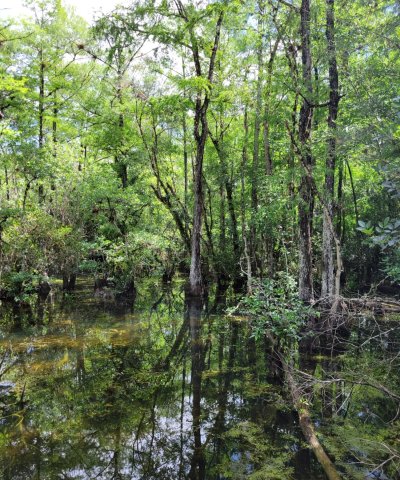
Figure 12. Interior cypress swamp in Big Cypress National Preserve during the wet season. Standing water will collect from rainfall and overland flow from upland communities until it may flow out of the swamp as slow sheet water flow.

Figure 13. Buttressed trunks resulting from long hydroperiods found in interior cypress swamp in Big Cypress National Preserve. When water is absent from the system during the dry season sparse perennial hydrophytic species may grow in the understory.

Figure 14. Understory of interior cypress swamp in April in the Big Cypress National Preserve. As standing water collects from rainfall, sparse perennial hydrophytic species not found on micro highs will become inundated for the wet season.
The natural (native) vegetation of this state is mainly dominated by Bald Cypress and Pond Cypress (Taxodium distichum and T. ascendens, respectfully). Occasional fire contributes to the maintenance of a cypress dominated community; without fire, hardwood invasion and peat accumulation create a mixed hardwood and cypress swamp, and under certain conditions the strand may convert to a hardwood forest. In the center of the swamp, there may be open marshes or deeper sloughs. Cypress Swamps have small young trees towards their outer edges, grading into larger and older stands towards the interior, giving the community a distinctively rounded cross -section profile. This site occurs when organic soils accumulate in depressions that are inundated for much of the year, particularly during summer months when litter decomposition rates are high. These organic soils create a unique environment that increases species diversity and structural development in South Florida wetland communities.
Characteristics and indicators. This state is characterized by nearly pure stands of cypress trees (Taxodium spp.) that are distinguished by buttressed trunks. They have smaller, younger trees along the periphery of the swamps, grading into larger and older trees in the center. This gives the community a distinctively rounded cross-section profile.
Resilience management. This state is maintained by both stressors from water and fire. Hydroperiods range from 200 to 300 days per year which only allow flooding tolerant species to survive. Drainage of this site can allow for the invasion of non-native and exotic species and transition the site to a more mesic hardwood community. Fire is another major stressor in this state, with interior swamps burning at long time periods up to every 100 to 150 years, and the edges every 3 to 5 years. The stress from fire prevents the accumulation of organic matter and transition into a hardwood community.
Dominant resource concerns
Community 1.1
Dome Swamp
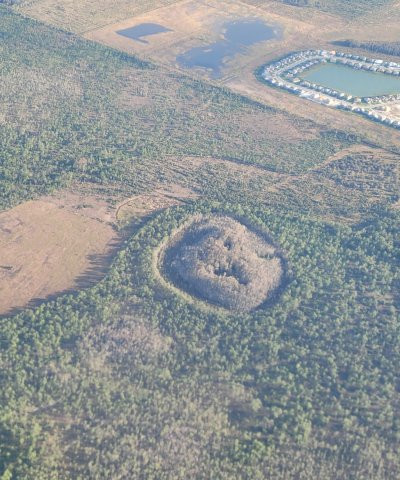
Figure 15. Isolated Cypress Dome as seen from above within pyrogenic flatwoods community. While it looks like a dome from afar on the ground, dome swamps may have open depressions in the center, giving it a doughnut appearance.
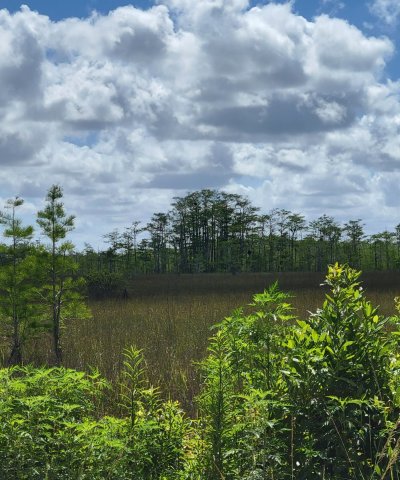
Figure 16. Cypress dome seen from afar in summer. Oldest tallest trees grow in the center while younger smaller trees grow on the periphery, giving it a characteristic dome shape.

Figure 17. Cypress dome seen from afar in winter. Cypress are deciduous conifers which drop their needles in the winter months.
Typically defined as an isolated, forested, depression wetland occurring within a fire-maintained community. These swamps are generally small but may also be large and shallow. They occur when acid byproducts of organic matter decomposition dissolve limestone bedrock causing the soil to slump over the sinkhole, creating a conical depression. These domes have thick layers of peat in the center which is able to hold water for the majority of the year, with the tallest, biggest cypress trees in the center of the dome and smallest, youngest cypress trees on the outskirts. This gives the dome a distinctly rounded cross-sectional profile. Isolated freshwater marshes in the center of the dome can also give it a doughnut shape from aerial views. The isolated deep center zone of a dome swamp will have open water support submerged aquatic vegetation and floating species in the wet season, and can support herbaceous grasses and forbs during the short dry periods.
Resilience management. These wetlands function as reservoirs that recharge the aquifer when adjacent water tables drop and fluctuate with seasonal rainfall. The normal hydroperiod is 200 to 300 days out of the year which acts as a stressor to maintain this community to prevent transition to another community. Normal fire return intervals range anywhere form 3 to 5 years along the outer edge to as long as 100 to 150 years along the inner dome. Fire is used to maintain this community, without periodic fires hardwood invasion and peat accumulation would convert the dome to a hardwood forest. Depending on the extent of limestone trough or sinkhole, the dome swamp may expand into an irregular formed strand swamp.
Dominant plant species
-
pond cypress (Taxodium ascendens), tree
-
red maple (Acer rubrum), tree
-
dahoon (Ilex cassine), tree
-
swamp bay (Persea palustris), tree
-
Florida slash pine (Pinus elliottii var. densa), tree
-
sweetbay (Magnolia virginiana), tree
-
loblolly bay (Gordonia lasianthus), tree
-
coco plum (Chrysobalanus icaco), tree
-
pond apple (Annona glabra), tree
-
Virginia sweetspire (Itea virginica), shrub
-
fetterbush lyonia (Lyonia lucida), shrub
-
common buttonbush (Cephalanthus occidentalis), shrub
-
coastal plain willow (Salix caroliniana), shrub
-
wax myrtle (Morella cerifera), shrub
-
St. Johnswort (Hypericum), shrub
-
maidencane (Panicum hemitomon), grass
-
Jamaica swamp sawgrass (Cladium mariscus ssp. jamaicense), grass
-
beaksedge (Rhynchospora), grass
-
Virginia chainfern (Woodwardia virginica), other herbaceous
-
royal fern (Osmunda regalis var. spectabilis), other herbaceous
-
cinnamon fern (Osmunda cinnamomea), other herbaceous
-
toothed midsorus fern (Blechnum serrulatum), other herbaceous
-
lizard's tail (Saururus cernuus), other herbaceous
-
Carolina redroot (Lachnanthes caroliana), other herbaceous
-
taperleaf water horehound (Lycopus rubellus), other herbaceous
-
false nettle (Boehmeria), other herbaceous
-
knotweed (Polygonum), other herbaceous
-
sphagnum (Sphagnum), other herbaceous
-
eastern poison ivy (Toxicodendron radicans), other herbaceous
-
white twinevine (Funastrum clausum), other herbaceous
-
airplant (Tillandsia), other herbaceous
-
bent alligator-flag (Thalia geniculata), other herbaceous
-
bulltongue arrowhead (Sagittaria lancifolia), other herbaceous
Community 1.2
Strand Swamp

Figure 18. Exterior of a Strand Swamp in the Big Cypress National Preserve seen from afar in the winter.
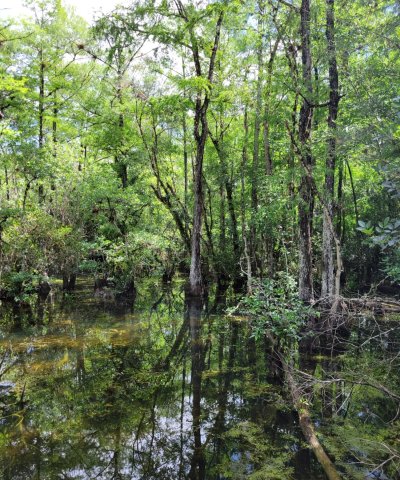
Figure 19. Strand Swamp in the Big Cypress National Preserve. These wetlands have long hydroperiods and can hold water for 200 to 300 days per year.
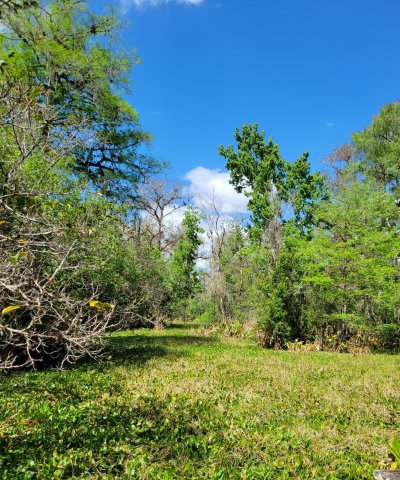
Figure 20. Center of a Strand Swamp in the Big Cypress Ecoregion. This area has the deepest organic material with hydroperiods that often last throughout the year. It is dominated by floating aquatic emergent vegetation or open water.
Strand Swamps are shallow, forested, usually elongated depression or channel situated in a trough within a flat limestone plain, with small, young, cypress trees at the outer edge grading into large, old cypress trees in the interior. The strand has a distinctly rounded cross-sectional profile. Strand swamps are deepest and have peat towards the center, with the edges having little organic matter over sand. Microsites found on cypress knees or slight topographic highs permit for more mesic species to be found in this highly diverse community. This community will often form from continuing lowering of bedrock surface by dissolution and mechanical break up of cap rocks by trees, connecting isolated dome swamps into a larger isolated swamp system.
Resilience management. These wetlands function as reservoirs that recharge the aquifer when adjacent water tables drop and fluctuate with seasonal rainfall. The normal hydroperiod is 200 to 300 days out of the year which acts as a stressor to maintain this community to prevent transition to another community. Normal fire return intervals range anywhere form 3 to 5 years along the outer edge to as long as 100 to 150 years along the inner swamp. Fire is used to maintain this community, without periodic fires hardwood invasion and peat accumulation would convert the dome to a hardwood forest.
Dominant plant species
-
pond cypress (Taxodium ascendens), tree
-
bald cypress (Taxodium distichum), tree
-
red maple (Acer rubrum), tree
-
pond apple (Annona glabra), tree
-
laurel oak (Quercus laurifolia), tree
-
cabbage palmetto (Sabal palmetto), tree
-
Florida strangler fig (Ficus aurea), tree
-
swamp bay (Persea palustris), shrub
-
sweetbay (Magnolia virginiana), shrub
-
coastal plain willow (Salix caroliniana), shrub
-
wax myrtle (Morella cerifera), shrub
-
common buttonbush (Cephalanthus occidentalis), shrub
-
Jamaica swamp sawgrass (Cladium mariscus ssp. jamaicense), grass
-
seven sisters (Crinum americanum), other herbaceous
-
inland leatherfern (Acrostichum danaeifolium), other herbaceous
-
toothed midsorus fern (Blechnum serrulatum), other herbaceous
-
royal fern (Osmunda regalis var. spectabilis), other herbaceous
-
airplant (Tillandsia), other herbaceous
-
white twinevine (Funastrum clausum), other herbaceous
-
waterhyssop (Bacopa), other herbaceous
Pathway 1.1A
Community 1.1 to 1.2
Swamp expansion occurs via seeding from trees and seed dispersal from birds or other animals. If the conditions are met for dome swamps to expand then they will grow out to form a strand swamp over a long period of time.
Context dependence. Swamp expansion can occur if the depression in the limestone bedrock that formed the dome swamp extends further out. If the dome swamp exists within a limestone trough it may extend to form a fully developed strand swamp. This is not only a spatially depending process, depending on the depressions formed in limestone bedrock that allows peat accumulation, but temporally dependent as well. For the swamp to expand larger it would take centuries to achieve full growth in the representative landscape. This is also depending on the natural landscape remaining the same with no alterations in land use changes or hydrologic flow.
State 2
Mixed Hardwood Swamps
Hardwood swamps are dominated by a mix of hydrophytic hardwood trees including bays and cabbage palms. This state occurs on low, wet sites and has short hydroperiods that are inundated seldom over 60 days per year, but are maintained on a consistently saturated peat substrate. These communities form within the Big Cypress region when fire is excluded from cypress swamps for an extended period, allowing organic matter accumulation to create shallower depressions in the landscape, shortening the hydroperiod. With greater accumulation of organic matter and a shortened hydroperiod, hardwood vegetation can become established and, over time, shade out the existing vegetation. Shading from the newly established hardwood species will perpetuate organic matter accumulation and moist soil conditions, favoring this state, continuing the expansion of these communities.
Characteristics and indicators. Hardwood swamps are characterized by hardwood hydrophytic species such as bays and cabbage palms as well as cypress. They are constantly saturated but only inundated for about 60 days per year during the wet season of the summer months (June- October).
Resilience management. The main influencing factors in this state consist of infrequent to occasional fires and long term hydroperiods. Human alterations to surrounding communities can inadvertently drain these sites, making them susceptible to catastrophic fires, in which the organic matter accumulation will be lost, reverting the community back to cypress swamp vegetation or to shrub thickets, depending on the root damage from the fire. Increases in long term hydroperiods will shift the community back towards a cypress swamp as the hardwood species can tolerate some flooding but not the same amount as cypress. Drainage will allow for invasive species to become established that can outcompete the native vegetation.
Dominant resource concerns
-
Subsidence
-
Organic matter depletion
-
Ponding and flooding
-
Seasonal high water table
-
Nutrients transported to surface water
-
Plant productivity and health
-
Plant structure and composition
Community 2.1
Cypress Dominated Baygall
Baygall, also referred to as bay swamps or bay heads, are evergreen forested wetlands of bay species in a large basin with deep peat soils that are acidic within a well developed forest. They typically develop on wet soils in depressions and in stagnant drainages that maintain a saturated peat substrate via seepage, rainfall, or capillary action. This community varies in size and can range from small tree islands within marsh or prairie communities to many acres within a mature forest. Within the Big Cypress ecoregion this community is restricted to pockets on tree islands and within mature cypress swamps. They develop when fire has been excluded from cypress swamps, allowing organic matter to accumulate and creating a positive feedback that allows the establishment of bays. Cypress swamps are very similar to baygalls, with many instances of intermediate stages between these communities primarily caused by fire and logging history. However, cypress swamps experience greater water fluctuation and greater water depths than baygalls
Resilience management. As the bay species grow, the shade intolerant cypress species are inhibited which shifts vegetation and soil conditions to favor shade intolerant species to germinate and grow in low light conditions.
Community 2.2
Shrub Thicket
This community is the result from a peat fire that killed the existing root system of the dominant hardwood species. Where the peat layer and root systems are destroyed, the area may be lowered and dominant hardwood and regenerating cypress killed. The area may then be replaced by a monospecific stand of willow or pop ash, which have readily dispersible seeds.
Resilience management. Lack of fire is used to maintain this community and what differentiates it from shrub bogs. Over time the lack of fire will cause a transition back to a baygall community as accumulation of organic matter raises the surface of the ground above the seasonal high water table and allow for hardwood species to regrow. Due to their low position in the landscape this can be anywhere from a few centimeters to a few inches difference from seasonal flooding to being dry.
Pathway 2.1A
Community 2.1 to 2.2
A deep peat burn consumes the medium in which roots grow and thus eliminates recovery by resprout. Trees that survive with fire-damaged roots may later be blown over in high intensity storm events. Depending on the amount of peat burned, the ground level may be lowered so much the hydroperiod may be too long for cypress regeneration. The lowered peat and longer hydroperiod allow for the growth of shrub thickets such as willow heads or bays. If the ground level is lowered far enough, open water may create an open lake.
Context dependence. Fires that can destroy the peat layer typically happen during periods of drought, when the water table is lowered enough for the peat to begin to dry out and readily burn. Fires can be devastating and burn very rapidly through this area or can smolder for long periods of time.
Pathway 2.2A
Community 2.2 to 2.1
The main driver in this transition is the absence of fire which allows the accumulation of organic matter. This can raise the surface of the ground by a few centimeters or inches which will change the depth to the seasonal high water table allowing for the full development of bay species.
Context dependence. Growth of hardwood species can cause a positive feedback loop in which the ground layer becomes shaded and remains moist for longer periods, excluding fire from the system and allowing for the accumulation of organic matter which can raise the ground surface over time.
State 3
Invasive Non-Native Community
This state consists of Florida Department of Agriculture and Consumer Services (FDACS) Non-Native Category 1 Species list . More information on these species list can be found:
https://www.fdacs.gov/content/download/63140/file/Florida%E2%80%99s_Pest_Plants.pdf
or by contacting the UF / IFAS Center for Aquatic and Invasive Plants (http://plants.ifas.ufl.edu/),
the UF / IFAS Assessment of Non-native Plants in Florida's Natural Areas (https://assessment.ifas.ufl.edu/),
or the FWC Invasive Plant Management Section (http://myfwc.com/wildlifehabitats/invasive-plants/).
This community will not represent every possibility of invasive species but rather the most common in these areas.
Characteristics and indicators. Non-Native species include species that exist outside of Florida's natural range and are introduced to the state via people, weather events, or any other means.
Resilience management. This state can be found as a part of any other state or community and can completely destroy the native habitat if not properly managed. Restoration to natural communities after exotic invasion include practices such as mechanical and chemical removal.
Dominant resource concerns
-
Subsidence
-
Concentration of salts or other chemicals
-
Nutrients transported to surface water
-
Plant productivity and health
-
Plant structure and composition
State 4
Managed Resource Areas
The following communities comprise the major land uses in the United States and the land uses receiving the majority of the conservation treatment that address soil, water, air, plant, and animal resources within the USDA.
Characteristics and indicators. These land uses consist of areas that are not completely naturalized (i.e. native habitat) but are not completely altered by anthropogenic means.
Dominant resource concerns
-
Sheet and rill erosion
-
Wind erosion
-
Subsidence
-
Organic matter depletion
-
Concentration of salts or other chemicals
-
Seasonal high water table
-
Nutrients transported to surface water
-
Inadequate livestock shelter
Community 4.1
Rangeland
Rangelands are described as lands on which the indigenous vegetation is predominately grasses, grass-like plants, forbs, and possibly shrubs or dispersed trees. Existing plant communities can include both native and introduced plants. Primary export from Florida ranges are cattle and have been present in the state since their first introduction by Spanish explorers in 1521. This is the reference community for this state because it requires very little alterations to the landscape for grazing species.
Rangelands provide a diversity of ecosystems and also provide a diverse and significant production of economic benefits and ecosystem goods and services. Livestock production along with sustainable wildlife populations provide for the major direct economic benefits, but also tourism, recreational uses, minerals/energy production, renewable energy, and other natural resource uses can be very significant. Vital ecosystem contributions include clean water, clean air, fish/wildlife habitat, as well as intangible considerations such as historical, cultural, aesthetic and spiritual values.
Resilience management. Grazing, by both domestic livestock and wildlife, is the most common ecological management process, with fire and weather extremes also being significant ecological factors. For information regarding specific cattle grazing techniques please contact your local NRCS office.
Community 4.2
Open Transitional Managed Communities
This is an area that is managed to maintain open land before shifting to another community. These communities are often used as transitional periods from one practice to another and could lead to an abandoned / fallow field.
Community 4.3
Improved Pasture
Pasture is a land use type having vegetation cover comprised primarily of introduced or enhanced native forage species that is used for livestock grazing. Pasture vegetation can consist of grasses, legumes, other forbs, shrubs or a mixture. The majority of these forages are introduced, having originally come from areas in other states or continents. Most are now naturalized and are vital components of pasture based grazing systems.
Pasture lands provide many benefits other than forage for livestock. Wildlife use pasture as shelter and for food sources. Well managed pasture captures rainwater that is slowly infiltrated into the soil which helps recharge groundwater. Many small pasture livestock operations are near urban areas providing vistas for everyone to enjoy.
Resilience management. Pastures receive periodic renovation and cultural treatments such as tillage, fertilization, mowing, weed control, and may be irrigated. For more information regarding specific pasture management please contact your local NRCS office.
Community 4.4
Agriculture
The agriculture industry includes cultivated crops, aquaculture, and apiculture. Cultivated cropland includes areas used for the production of adapted crops for harvest. These areas comprises land in row crops or close-grown crops that are in a rotation with row or close-grown crops. Primary export from Florida consists of fruits, greenhouse and nursery products, sugar cane, and the signature export of citrus. Aquaculture includes the cultivation and maintenance of aquatic plants, aquatic reptiles, crustaceans, food/ ornamental fish, shellfish, and other miscellaneous species for harvesting. Apiculture includes the maintenance of honeybees and hives to provide beeswax, honey/ other edible bee products, crop pollination services, and sales of bees to other beekeepers. These areas have been modified resulting in land clearing practices and hydrologic management to fit the growers needs.
Resilience management. Major natural resource concerns facing cropland include: (1) erosion by wind and water, (2) maintaining and enhancing soil quality, (3) water quality from nutrient and pesticides runoff and leaching, and (4) managing the quantity of water available for irrigation. For more specific information regarding cropland please contact your local NRCS office.
Community 4.5
Silviculture
Silviculture is land used in controlling the establishment, growth, composition, health, and quality of forests and woodlands to meet the diverse needs and values of landowners and society such as wildlife habitat, timber, water resources, restoration, and recreation on a sustainable basis. These are forestry practices that include thinning, harvesting, planting, pruning, prescribed burning and site preparation, for managed goals such as wildlife habitat creation or harvesting. Many managed silvicultural lands in Florida include tree plantations for growth of tropical ornamental species such as palms; and lumber, pulp, and paper species such as slash pine, longleaf pine, cypress, and eucalyptus.
This community also include management practices of agroforestry, the intentional mixing
of trees and shrubs into crop and/or animal production systems to create environmental, economic and social benefits. This is included in this community and not any other state because the primary management is for tree species. This may include practices such as riparian forest buffers, windbreaks, forest farming, silvopasture, and alley cropping.
Resilience management. Management of silvicultural lands require specific prescriptions based on the management goals for the stand, and may include thinning, harvesting, planting, pruning, prescribed burning and site preparation. For more information regarding specific management for silviculture practices please contact your local NRCS office.
Pathway 4.1A
Community 4.1 to 4.2
This pathway is driven by land clearing practices that consists of removing the existing vegetation from the habitat and altering the habitat to prepare for modified land use.
Pathway 4.2A
Community 4.2 to 4.1
This pathway is driven by the restoration of the native habitat for the use of rangeland. This includes restoration of both the natural hydroperiod and landscape in advance of replanting native species. This is a time-consuming process and often results in second-hand community structure. Once restored to a natural capacity the introduction of grazing species to the system creates a managed rangeland.
Pathway 4.2B
Community 4.2 to 4.3
This pathway is driven by preparing the land for pasteurization. This includes the planting of vegetation consisting of grasses, legumes, other forbs, shrubs or a mixture that will provide preferred forage for managed grazing species.
Pathway 4.2C
Community 4.2 to 4.4
This pathway is driven by the preparation of land for agricultural uses. This change is dependent on the type of agricultural community is being created, but often depends on the growing, maintenance, and cultivation of an agricultural product for consumers. This community may require modification to the land to fit the hydrologic requirement of the growing crop.
Pathway 4.2D
Community 4.2 to 4.5
This pathway is driven by the preparation of the land for silvicultural purposes. This change is dependent on the type of silvicultural product being cultivated, as many different practices require different growth requirements.
Pathway 4.3A
Community 4.3 to 4.2
This pathway is driven by land clearing practices that consists of removing the existing vegetation from the habitat and altering the habitat to prepare for modified land use.
Pathway 4.3B
Community 4.3 to 4.4
This pathway is driven by the preparation of land for agricultural uses. This change is dependent on the type of agricultural community is being created, but often depends on the growing, maintenance, and cultivation of an agricultural product for consumers. This community may require modification to the land to fit the hydrologic requirement of the growing crop.
Pathway 4.3C
Community 4.3 to 4.5
This pathway is driven by the preparation of the land for silvicultural purposes. This change is dependent on the type of silvicultural product being cultivated, as many different practices require different growth requirements.
Pathway 4.4A
Community 4.4 to 4.2
This pathway is driven by land clearing practices that consists of removing the existing vegetation from the habitat and altering the habitat to prepare for modified land use.
Pathway 4.4B
Community 4.4 to 4.5
This pathway is driven by the preparation of the land for silvicultural purposes. This change is dependent on the type of silvicultural product being cultivated, as many different practices require different growth requirements.
Pathway 4.5A
Community 4.5 to 4.2
This pathway is driven by land clearing practices that consists of removing the existing vegetation from the habitat and altering the habitat to prepare for modified land use.
State 5
Human Altered and Human Transported Areas
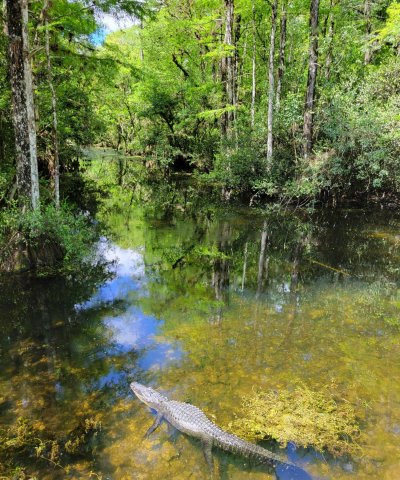
Figure 21. Human Altered / Transported Areas such as this old canal in the Big Cypress National Preserve was used to drain water out of the system in the mid 1900s to urbanize and log the area.
These areas include soils that were intentionally and substantially modified by humans for an intended purpose, commonly for terraced agriculture, building support, mining, transportation, and commerce. The alteration is of sufficient magnitude to result in the introduction of a new parent material (human-transported material) or a profound change in the previously existing parent material (human-altered material). They do not include soils modified through standard agricultural practices or formed soils with unintended wind and water erosion. When a soil is on or above an anthropogenic landform or microfeature, it can be definitely associated with human activity and is assigned to a unique taxa, usually found as an "Urban land complex" within that communities' natural soil properties (e.g., Immokalee sand-Urban land complex, 0 to 2 percent slopes).
Resilience management. Evidence of these areas include soils with manufactured items (e.g. artifacts) present in the profile, human altered-materials (e.g., deeply excavated or deeply plowed soil) or human-transported material (e.g., fill), and position on or above anthropogenic landforms (e.g., flood-control levees) and microfeatures (e.g., drainage ditches). Detailed criteria regarding the identification of anthropogenic (artificial) landforms, human-altered materials, and human-transported material are in the "Keys to Soil Taxonomy" (Soil Survey Staff, 2014).
Dominant resource concerns
-
Compaction
-
Ponding and flooding
-
Seasonal high water table
-
Emissions of greenhouse gases (GHGs)
-
Objectionable odors
-
Plant productivity and health
-
Plant structure and composition
Community 5.1
Reclaimed Areas
Reclaimed areas are areas that have been modified through anthropogenic means that are restored to a natural or second-hand natural community. Areas that can be reclaimed are any intensity urban areas, and may be required to be reclaimed after urban use (e.g., active mines must be reclaimed). These practices include the identification, removal, and stockpiling soil materials before altering the land, and revegetation and replacement of soil materials after altering the land. This also applies to nearby urban areas that have been adversely affected by the anthropogenic activities.
Community 5.2
Urban
This urban community consists of development for human use. Urban areas include a variety of land uses, e.g., inner city or urban core, industrial and residential areas, cemeteries, parks, and other open spaces; the overall function which may benefit the quality of human life. These often form an urban soil mosaic, where the natural landscape has been fragmented into parcels with distinctive disturbance and management regimes and, as a result, distinctive characteristic soil properties.
Within this community there are three different levels of urbanization, based off population dynamics, residential density, and intensity of development. These are labeled as low-intensity, medium-intensity, and high-intensity urban areas, which can eventually be split apart into its own separate state. Low-intensity urban areas may consist of single dwelling homes with little impact on the surrounding community which still somewhat represents the natural community (e.g., represents natural landscape, hydrology, and vegetation) , other examples of this are urban parks, cemeteries, or campgrounds with little urban development. Medium-intensity urban areas consist of larger urban dwellings with some natural features, but have been modified to meet urban needs (e.g., towns). High-intensity urban areas are areas of heavily modified areas with complete alterations of the natural landscape, hydrology, and vegetation to support a very large population, which once constructed is permanently altered (e.g., metropolis areas/ active mines).
Community 5.3
Non-Reclaimed Areas
Non-reclaimed areas are areas that have been modified through anthropogenic means that are unable to be restored to a natural or second-hand natural community. Areas that cannot be reclaimed are areas under active mining status or mined areas before the Phosphate Land Reclamation Act in 1975, which leaves shut down operations alone. These areas also include fallow mines that have been flooded and are now permanent bodies of water.
Community 5.4
Landfills
This is an anthropogenic site for the disposal of waste material. It includes manufactured layers (artificial, root limiting layer below the soil surface) that are representative of human altered and human transported sites. These layers are often alternative between natural fill material and geotextile liners, asphalt, concrete, rubber or plastic that are built up and can rise above the surrounding landscape by 30 meters or more often impeding water, gas, or roots from moving through the profile.
Pathway 5.1A
Community 5.1 to 5.2
This shift in communities is driven by clearing and developing the land for the desired community.
Pathway 5.1B
Community 5.1 to 5.4
This transition is driven by the deposition of manufactured layers along with anthropogenic waste which is consistently built upon.
Pathway 5.2A
Community 5.2 to 5.1
This transition is driven by the revegetation, reestablished hydroperiods, and replacement of displaced soil materials after altering the land.
Pathway 5.2B
Community 5.2 to 5.3
This transition is driven from heavy industrial or urban development which causes the land to become non-reclaimable. This transition is rare due to the many environmental laws and regulations that must be followed when developing.
Pathway 5.2C
Community 5.2 to 5.4
This transition is driven by the deposition of manufactured layers along with anthropogenic waste which is consistently built upon.
Pathway 5.3A
Community 5.3 to 5.1
This transition is driven by the revegetation, reestablished hydroperiods, and replacement of displaced soil materials after altering the land.
Transition T1A
State 1 to 2
Cypress swamps are dependent on light surface fires as well as long hydroperiods to help maintain community structure and composition. These fires should be allowed to burn naturally within the swamp and be extinguished along natural breaks. In areas where fire has been removed for long periods of time accumulation of organic matter can accumulate and raise the ground surface to allow for the growth of hardwood species.
This transition is also driven by logging, where the cut stumps of cypress may coppice readily. During the period of cypress regrowth other hydrophytic hardwood species may become established in the canopy, and form a mixed hardwood cypress swamp when the cypress return to maturity.
Constraints to recovery. Growth of hardwood species can cause a positive feedback loop in which the ground layer becomes shaded and remains moist for longer periods, excluding fire from the system and allowing for the accumulation of organic matter which can raise the ground surface over time.
Context dependence. This is a long transitional process if occurring naturally, as cypress swamps have fire return intervals ranging from 3 to 5 years along the periphery to over 150 years towards the center of the swamp. Cypress swamps that have bay species in the sub canopy are close to this transition.
Much of the cypress swamps in the Big Cypress eco region were logged during the mid-20th century, during the second World War. Many of the old growth cypress trees were sought due to their decay resistant properties for the development of housing during and after the war.
Transition T1B
State 1 to 3
The invasion of non-native or exotic species can be driven by a multitude of different environmental factors such as changes in natural hydroperiods or in fire regimes. Typically once a change in one of the two factors mentioned above occurs, non-native or exotic invasive species become established and begin to compete with native species for habitat and nutrients.
Constraints to recovery. Recovery from non-native or exotic invasive species may be difficult due to many adaptations which allow them to outcompete and survive in altered conditions. Localized knowledge for each species must be known for best removal of it without harming the native environment, and often different treatments must be applied over one given area.
Context dependence. Growth of non-native and exotic invasive species can be rapid following a change in a natural stressor such as fire frequency or natural hydroperiods which might have once kept the invasive species at bay.
Transition T1C
State 1 to 4
This transition is driven by the decrease in localized long term hydroperiods and modifying the land for the desired land use. This may include the establishment of grazing species or the modification of land for the cultivation of crops of other desired products.
Transition T1D
State 1 to 5
Human Altered and Human Transported Areas
This transition is driven by the decrease in localized long term hydroperiod and the alteration and/ or transportation of soils materials via anthropogenic means.
Transition T2A
State 2 to 1
Transition from mixed hardwood dominated swamps to cypress swamps is mainly influenced by hydroperiods, climate, and fire. Fire must be reestablished within the system to slightly lower the ground level, increasing the hydroperiod and slowly weakening and eventually killing the hardwood species. Available space allows cypress to regenerate with tolerable hydroperiod and fire conditions.
Constraints to recovery. Fire must be reestablished into the system and is dependent on climatic variables as well influences from surrounding pyrogenic communities.
Context dependence. Cypress species are tolerant of light surface fires, helping maintain species composition, but hardwoods and upland conifers are not. These species are killed by surface fires by not only slightly lowering the ground level and increasing the hydroperiods, but through their root systems. The high water tables in cypress swamps forces these species to maintain shallow root systems, which would be weaken and eventually kill these species.
Transition T2B
State 2 to 3
The invasion of non-native or exotic species can be driven by a multitude of different environmental factors such as changes in natural hydroperiods or in fire regimes. Typically once a change in one of the two factors mentioned above occurs, non-native or exotic invasive species become established and begin to compete with native species for habitat and nutrients.
Constraints to recovery. Recovery from non-native or exotic invasive species may be difficult due to many adaptations which allow them to survive and outcompete in intolerable conditions. Localized knowledge for each species must be known for best removal of it without harming the native environment, and often different treatments must be applied over one given area.
Context dependence. Growth of non-native and exotic invasive species can be rapid following a change in a natural stressor such as fire frequency or natural hydroperiods which might have once kept the invasive species at bay.
Transition T2C
State 2 to 4
This transition is driven by the decrease in localized long term hydroperiods and modifying the land for the desired land use. This may include the establishment of grazing species or the modification of land for the cultivation of crops of other desired products.
Transition T2D
State 2 to 5
This transition is driven by the decrease in localized long term hydroperiod and the alteration and/ or transportation of soils materials via anthropogenic means.
Restoration pathway R3A
State 3 to 1
Mechanical, biological, and chemical removal strategies include removing the non-native and exotic invasive species through various mechanisms. Localized knowledge for individual non-native or exotic invasive species is needed for specific management. Sometimes introduction of fire regimes may prevent or stop the growth of non-native or exotic invasive species, but many species are fire tolerant. Mechanical removal might include roller chopping, harvesting, or cutting and removal of invasive species. Chemical removal might include aerial dispersal from planes, or basal bark injection treatments.
Context dependence. Mechanical, biological, and chemical removal of non-native and exotic invasive species is a time dependent process, with both removal types taking long times to be considered effective.
Restoration pathway R3B
State 3 to 2
Mechanical, biological, and chemical removal strategies include removing the non-native and exotic invasive species through various mechanisms. Localized knowledge for individual non-native or exotic invasive species is needed for specific management. Sometimes introduction of fire regimes may prevent or stop the growth of non-native or exotic invasive species, but many species are fire tolerant. Mechanical removal might include roller chopping, harvesting, or cutting and removal of invasive species. Chemical removal might include aerial dispersal from planes, or basal bark injection treatments.
Context dependence. Mechanical, biological, and chemical removal of non-native and exotic invasive species is a time dependent process, with both removal types taking long times to be considered effective.
Restoration pathway R3C
State 3 to 4
Mechanical, biological, and chemical removal strategies include removing the non-native and exotic invasive species through various mechanisms. Localized knowledge for individual non-native or exotic invasive species is needed for specific management. Sometimes introduction of fire regimes may prevent or stop the growth of non-native or exotic invasive species, but many species are fire tolerant. Mechanical removal might include roller chopping, harvesting, or cutting and removal of invasive species. Chemical removal might include aerial dispersal from planes, or basal bark injection treatments.
Context dependence. Mechanical, biological, and chemical removal of non-native and exotic invasive species is a time dependent process, with both removal types taking long times to be considered effective.
Transition T3A
State 3 to 5
This transition is driven by the decrease in localized long term hydroperiod and the alteration and/ or transportation of soils materials via anthropogenic means.
Restoration pathway R4A
State 4 to 1
These practices include the restoration of both the natural hydroperiod and landscape in advance of revegetating the area (if needed).
Restoration pathway R4B
State 4 to 2
These practices include the restoration of both the natural hydroperiod and landscape in advance of revegetating the area (if needed).
Transition T4A
State 4 to 3
The invasion of non-native or exotic species can be driven by a multitude of different environmental factors such as changes in natural hydroperiods or in fire regimes. Typically once a change in one of the two factors mentioned above occurs, non-native or exotic invasive species become established and begin to compete with native species for habitat and nutrients.
Context dependence. Recovery from non-native or exotic invasive species may be difficult due to many adaptations which allow them to outcompete and survive in intolerable conditions. Localized knowledge for each species must be known for best management of it it without harming the natural habitat, and often different treatments must be applied over one given area.
Growth of non-native and exotic invasive species can be rapid following a change in a natural stressor such as fire frequency or natural hydroperiods which might have once kept the invasive species at bay.
Transition T4B
State 4 to 5
This transition is driven by the decrease in localized long term hydroperiod and the alteration and/ or transportation of soils materials via anthropogenic means.
